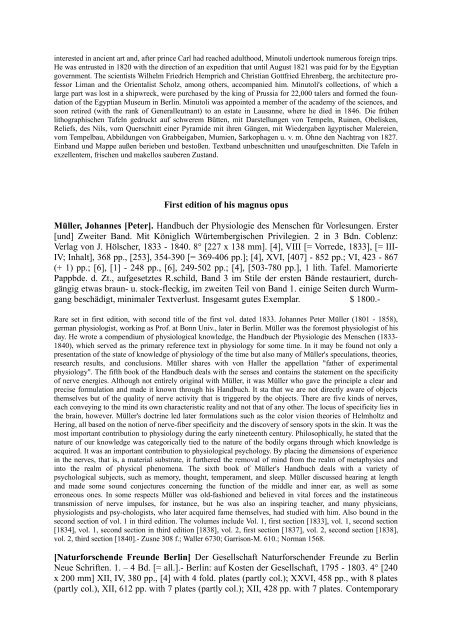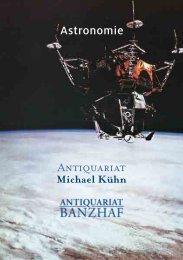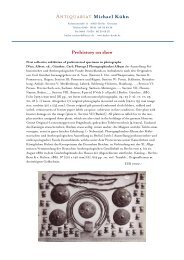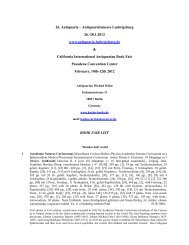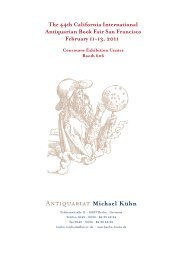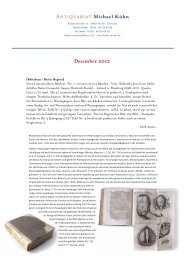List New York Antiquarian Book Fair - Antiquariat - Michael Kühn
List New York Antiquarian Book Fair - Antiquariat - Michael Kühn
List New York Antiquarian Book Fair - Antiquariat - Michael Kühn
You also want an ePaper? Increase the reach of your titles
YUMPU automatically turns print PDFs into web optimized ePapers that Google loves.
interested in ancient art and, after prince Carl had reached adulthood, Minutoli undertook numerous foreign trips.<br />
He was entrusted in 1820 with the direction of an expedition that until August 1821 was paid for by the Egyptian<br />
government. The scientists Wilhelm Friedrich Hemprich and Christian Gottfried Ehrenberg, the architecture professor<br />
Liman and the Orientalist Scholz, among others, accompanied him. Minutoli's collections, of which a<br />
large part was lost in a shipwreck, were purchased by the king of Prussia for 22,000 talers and formed the foundation<br />
of the Egyptian Museum in Berlin. Minutoli was appointed a member of the academy of the sciences, and<br />
soon retired (with the rank of Generalleutnant) to an estate in Lausanne, where he died in 1846. Die frühen<br />
lithographischen Tafeln gedruckt auf schwerem Bütten, mit Darstellungen von Tempeln, Ruinen, Obelisken,<br />
Reliefs, des Nils, vom Querschnitt einer Pyramide mit ihren Gängen, mit Wiedergaben ägyptischer Malereien,<br />
vom Tempelbau, Abbildungen von Grabbeigaben, Mumien, Sarkophagen u. v. m. Ohne den Nachtrag von 1827.<br />
Einband und Mappe außen berieben und bestoßen. Textband unbeschnitten und unaufgeschnitten. Die Tafeln in<br />
exzellentem, frischen und makellos sauberen Zustand.<br />
First edition of his magnus opus<br />
Müller, Johannes [Peter]. Handbuch der Physiologie des Menschen für Vorlesungen. Erster<br />
[und] Zweiter Band. Mit Königlich Würtembergischen Privilegien. 2 in 3 Bdn. Coblenz:<br />
Verlag von J. Hölscher, 1833 - 1840. 8° [227 x 138 mm]. [4], VIII [= Vorrede, 1833], [= III-<br />
IV; Inhalt], 368 pp., [253], 354-390 [= 369-406 pp.]; [4], XVI, [407] - 852 pp.; VI, 423 - 867<br />
(+ 1) pp.; [6], [1] - 248 pp., [6], 249-502 pp.; [4], [503-780 pp.], 1 lith. Tafel. Mamorierte<br />
Pappbde. d. Zt., aufgesetztes R.schild, Band 3 im Stile der ersten Bände restauriert, durchgängig<br />
etwas braun- u. stock-fleckig, im zweiten Teil von Band 1. einige Seiten durch Wurmgang<br />
beschädigt, minimaler Textverlust. Insgesamt gutes Exemplar. $ 1800.-<br />
Rare set in first edition, with second title of the first vol. dated 1833. Johannes Peter Müller (1801 - 1858),<br />
german physiologist, working as Prof. at Bonn Univ., later in Berlin. Müller was the foremost physiologist of his<br />
day. He wrote a compendium of physiological knowledge, the Handbuch der Physiologie des Menschen (1833-<br />
1840), which served as the primary reference text in physiology for some time. In it may be found not only a<br />
presentation of the state of knowledge of physiology of the time but also many of Müller's speculations, theories,<br />
research results, and conclusions. Müller shares with von Haller the appellation "father of experimental<br />
physiology". The fifth book of the Handbuch deals with the senses and contains the statement on the specificity<br />
of nerve energies. Although not entirely original with Müller, it was Müller who gave the principle a clear and<br />
precise formulation and made it known through his Handbuch. It sta that we are not directly aware of objects<br />
themselves but of the quality of nerve activity that is triggered by the objects. There are five kinds of nerves,<br />
each conveying to the mind its own characteristic reality and not that of any other. The locus of specificity lies in<br />
the brain, however. Müller's doctrine led later formulations such as the color vision theories of Helmholtz and<br />
Hering, all based on the notion of nerve-fiber specificity and the discovery of sensory spots in the skin. It was the<br />
most important contribution to physiology during the early nineteenth century. Philosophically, he stated that the<br />
nature of our knowledge was categorically tied to the nature of the bodily organs through which knowledge is<br />
acquired. It was an important contribution to physiological psychology. By placing the dimensions of experience<br />
in the nerves, that is, a material substrate, it furthered the removal of mind from the realm of metaphysics and<br />
into the realm of physical phenomena. The sixth book of Müller's Handbuch deals with a variety of<br />
psychological subjects, such as memory, thought, temperament, and sleep. Müller discussed hearing at length<br />
and made some sound conjectures concerning the function of the middle and inner ear, as well as some<br />
erroneous ones. In some respects Müller was old-fashioned and believed in vital forces and the instatineous<br />
transmission of nerve impulses, for instance, but he was also an inspiring teacher, and many physicians,<br />
physiologists and psy-chologists, who later acquired fame themselves, had studied with him. Also bound in the<br />
second section of vol. 1 in third edition. The volumes include Vol. 1, first section [1833], vol. 1, second section<br />
[1834], vol. 1, second section in third edition [1838], vol. 2, first section [1837], vol. 2, second section [1838],<br />
vol. 2, third section [1840].- Zusne 308 f.; Waller 6730; Garrison-M. 610.; Norman 1568.<br />
[Naturforschende Freunde Berlin] Der Gesellschaft Naturforschender Freunde zu Berlin<br />
Neue Schriften. 1. – 4 Bd. [= all.].- Berlin: auf Kosten der Gesellschaft, 1795 - 1803. 4° [240<br />
x 200 mm] XII, IV, 380 pp., [4] with 4 fold. plates (partly col.); XXVI, 458 pp., with 8 plates<br />
(partly col.), XII, 612 pp. with 7 plates (partly col.); XII, 428 pp. with 7 plates. Contemporary


